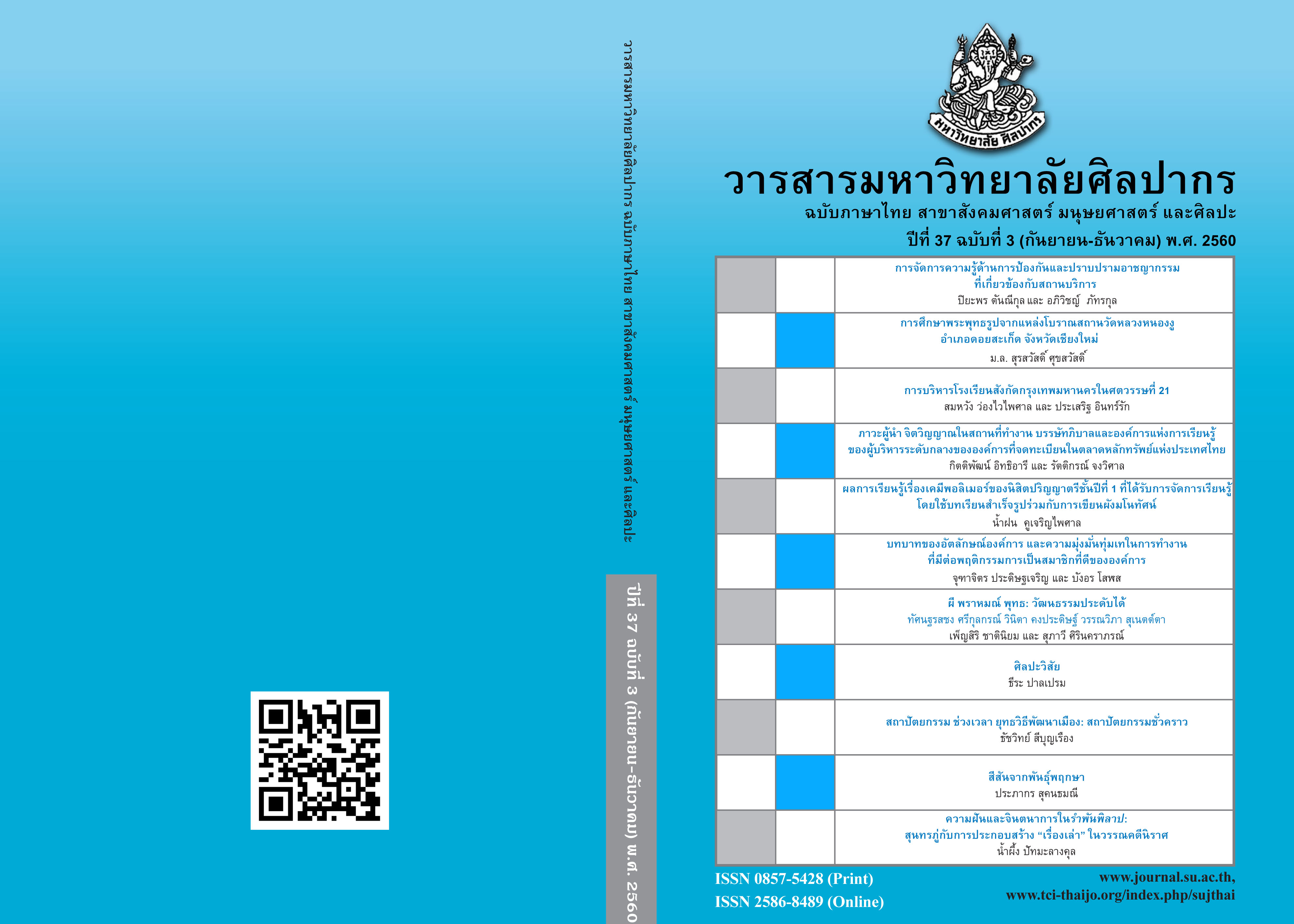ความฝันและจินตนาการในรำพันพิลาป: สุนทรภู่กับการประกอบสร้าง “เรื่องเล่า” ในวรรณคดีนิราศ (Dream and Imagination in Ramphanphilap:Sunthon Phu and a Construction of “Narrative” in Nirat)
Main Article Content
Abstract
บทความวิจัยนี้มุ่งศึกษากลวิธีการเล่าเรื่องใน รำพันพิลาป ของสุนทรภู่ โดยนำแนวคิดทางด้านศาสตร์แห่งการเล่าเรื่องจากทฤษฎีวรรณคดีวิจาณ์ตะวันตกมาประยุกต์ใช้เป็นแนวทางในการวิเคราะห์องค์ประกอบของการเล่าเรื่องที่ปรากฏใน รำพันพิลาป อันได้แก่ เหตุการณ์ ผู้เล่าเรื่อง ตัวละคร และฉาก ผลการวิจัยพบว่า รำพันพิลาป มีลักษณะเป็น “เรื่องเล่า” ที่มีโครงสร้างชัดเจน มีความฝันและจินตนาการเป็นองค์ประกอบสำคัญของการสร้างเรื่องราว และมีการประกอบสร้างที่เป็นเอกภาพเพื่อสื่อสารความในใจของกวีที่มีต่อนางผู้เป็นที่รัก นอกจากนี้ ผลการวิจัยยังแสดงให้เห็นว่า รำพันพิลาป มีการร้อยเรียงเหตุการณ์ที่เชื่อมโยงด้วยความสัมพันธ์ของเหตุการณ์แทนการคร่ำครวญด้วยกรอบของเวลาและเส้นทางการเดินทาง มีการสร้างผู้เล่าเรื่องที่มิใช่ผู้ครวญเพียงอย่างเดียวแต่ยังเป็นตัวละครที่มีบทบาทหลากหลาย มีการสร้างตัวละครประกอบและผู้ฟังในเรื่อง ตลอดจนมีการสร้างฉากที่แสดงการเล่นกับมิติของเวลาในลักษณะต่าง ๆ แต่ในขณะเดียวกัน รำพันพิลาป ก็มีการครวญซึ่งเป็นขนบสำคัญของนิราศเป็นองค์ประกอบหลักอยู่ด้วย รำพันพิลาป จึงเป็นงานที่มีความซับซ้อนและมีลักษณะผสมผสานระหว่าง “เรื่องเล่า” และขนบนิราศอย่างกลมกลืน
This research aims to study the narrative techniques in Sunthon Phu’s Ramphanphilap by applying the Western concepts of Narratology to analyze the events, the narrator, the characters, and the settings in the text. The findings of the research show that Ramphanphilap can be viewed as a “narrative” with a distinctive structure that has dream and imagination as its major components. The text also displays a unity of construction in which all elements are designed to convey the poet’s feelings towards his beloved. In addition, the research findings confirm that Ramphanphilap contains a chain of events rather than mere lamentation through time and journeys. The text also has a narrator who is not only a person who laments but also a character who has different roles and interactions with other characters and narratees. In terms of settings, the text displays various aspects of the game with time in a narrative. However, the research finds that despite of these narrative elements, Ramphanphilap remains having Nirat’s style of lamentation as its essential. The findings of the research, therefore, prove the complexity of Ramphanphilap as well as highlight its harmonious combination between a narrative and a convention of Nirat.
Downloads
Article Details
References
Bal, M. (2009). Narratology: Introduction to the Theory of Narrative (3rd ed.).Toronto: University of Toronto Press.
Boonkachorn, Trisilpa. (2016). House, Palace, Temple; All Are Enemy: Ramphanphilap as Sunthon Phu’s Autobiography (ทั้งบ้าน ทั้งวัง วัดเป็นศัตรู:รำพันพิลาปในฐานะวรรณกรรมอัตชีวประวัติสุนทรภู่). Kuengwichakan Journal, 37(2), 69-79. Retrieved on June 8, 2017, from https://www.tci-thaijo.org/index.php/rusamelae/article/viewFile/74788/60348.
Brewster, S. (2009). Lyric. Oxon, Great Britain: Routledge.
Bridgeman, T. (2007). Time and Space. In David Herman (Ed.). The Cambridge Companion to Narrative(pp. 52-65). New York: Cambridge University Press.
Chatman, S.(1980). Story and Discourse: Narrative Structure in Fiction and Film. Ithaca: Cornell University Press.
Cobley, P. (2001). Narrative. London: Routledge.Damrongrajanuphap. (1975). Sunthon Phu’s Life and Works (ชีวิตและงานของสุนทรภู่) (9th ed.). Bangkok: Khlang Withaya.
Eoseewong, N.(2012). Sunthon Phu: Bourgeois Poet Laureate (สุนทรภู่:มหากวีกระฎุมพี). In Pen and Sail: Literature and History in Early Bangkok (ปากไก่และใบเรือ: รวมความเรียงว่าด้วยวรรณกรรมแลประวัติศาสตร์สมัยต้นรัตนโกสินทร์) (4th ed.). Bangkok: Sameskybooks
Fine Art Department. (1970). Prince Thammathibet: Life and Poems (พระประวัติและพระนิพนธ์บทร้อยกรอง) (4th ed.). Bangkok: Silapabannakan.
Fludernik, M. (2009). An Introduction to Narratology (Patricia Häusler-Greenfield and Monika Fludernik, Trans.). New York: Routledge.
Harmon, W., & Holman, C.H. (1996). A Handbook to Literature (7th ed.). New Jersey: Prentice-Hall.
Khamwilai, C. (1999). An Article onRamphanphilap(บทความเรื่องรำพันพิลาป). In Ramphanphilap and Collection of Proverbial Poems by Sunthon Phu (รำพันพิลําปและประชุมกลอนสุภาษิตของสุนทรภู่).Bangkok:Sukhothaithammathirat.
Krasaesin, C. (1969). Thawatosamat Klong Dan (ทวําทศมําสโคลงดั้น). Bangkok: Sirimit Printing.
Na Mueangtai, T. (1997). Sunthon Phu’s Life (ชีวประวัติสุนทรภู่) (4th ed.). Bangkok: Thai Watana Panich.
Nimmannorathep, S. (1986). Plengyao Ramphanphilap (เพลงยาวรำพันพิลาป). In Commemoration of the 200th Anniversary of Sunthon Phu’s Birth (อนุสรณ์สุนทรภู่ 200 ปี). Bangkok: Association of Language and Books of Thailand under the Royal Patronage
Prince, G. (2000). Introduction to the Study of the Narratee. In Martin McQuillan (Ed.). The Narrative Reader (pp. 99-103). New York: Routledge.
Ricoeur, P.(1985). Time and Narrative (Volume 2) (Kathleen McLaughlin and David Pellauer, Trans.). Chicago: University of Chicago Press.
Royal Institute. (2002). Dictionary of Literary Terms English-Thai. Bangkok: Aroon Printing.
Ruengruglikit, C. (2005). Biography and Works of Sunthon Phu (ชีวประวัติและผลงานของสุนทรภู่) (3rd ed.). Bangkok: Project for the Publication of Academic Works, Faculty of Arts, Chulalongkorn University.
Sichamlong, P. (2004). Ramphanphilap (รำพันพิลาป). Art & Culture Magazine (ศิลปวัฒนธรรม), 25(8), 69-71.
Sichamlong, Phinyo. (2006). “Ramphanphilap” : Crystallized from the Poet’s Experiences; Superb in Literary Art and Philosophical Reflectionson Life (“รำพันพิลาป” กลั่นกรองจากประสบการณ์ ล้ำเลิศด้านโวหารศิลปะและปรัชญาชีวิต). In Wandering in the Poet’s World and Literary Appreciation in Sunthon Phu’s Works (ท่องโลกกวี เทิดอักษร สุนทรภู่)(2nd ed.). Bangkok: Banpinyo.
Sunthon Phu.(1967). Ramphanphilap: A New Edition with Notes, Photos, and Maps of Wat Thepthidaram (รำพันพิลําป ฉบับชำระใหม่และมีหมายเหตุพร้อมด้วยภาพแผนผังวัดเทพธิดาราม) (3rd ed.). Bangkok: Fine Arts Department.


